Obesity
Obesity is a growing problem among the pet population. At least 20% of dogs and cats are thought to be obese. It is a problem which causes animals to be at risk of many other diseases, but can be easily treated with dietary control and exercise changes.
What is Obesity?
- Obesity is defined as an animal weighing 15% more than their ideal body weight.
- Weight often creeps onto your pet over several months or years, so it can be difficult to notice at first.
- Obesity is now considered a serious medical condition, as it can mean your pet is at risk of developing other problems.
- In a minority of cases there is an underlying medical condition which causes the obesity, but in most overweight pets, the problem is caused by a combination of over-feeding and a lack of exercise
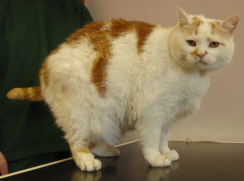
This cat is very over-weight.
How do I tell if my pet is over-weight?
Weight Charts
- For most breeds of dogs and cats there are recognised ‘ideal’ weights, to which your pet can be compared.
- These ideal weight charts can be usually found in your veterinary surgery, or on the internet.
- However, there is a large variation between individuals of the same breed, so the weight charts can only be used as a guide.
- Also, for cross breeds, it can be difficult to determine an ideal weight as these charts deal only with pedigrees.
Weight charts are usually available in you vets, they are a good place to start when determining your pets ideal weight.
Body Condition Scoring
- This is one of the best ways of determining of whether your pet is the ideal weight or not.
- Using the techniques below, each animal can be assessed individually to determine if it is over weight or not.
- There are 3 main things to look at when condition scoring your pet;
- Ribs and spine – run your hands along your pets sides and along their back. You should be able to easily feel the ribs and spine under a light covering of skin.
- From above – you should see a waist behind the chest, where the ribs finish and the abdomen begins.
- From the side – you should see a a nice ‘abdominal tuck’ where is body slopes upwards from the chest to the abdomen
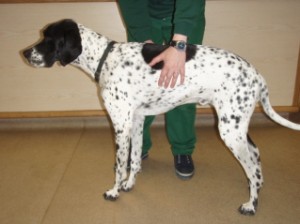
Place your hands on your pets chest, you should be able to feel the ribs easily.
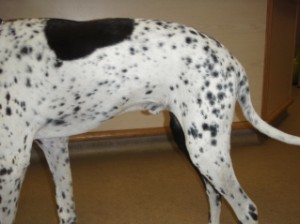
There should be an obvious ‘abdominal tuck’ behind your pets ribs.
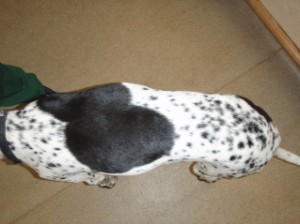
From above, your pet should have an obvious waist.
- There are several different body condition scoring charts available and these can be used to determine if your pet is over or under weight, and if so, by how much.
- 9 point condition scoring chart – this uses a 9 point scale, number 5 is considered the ideal weight.
- 3 point condition scoring chart – this is a simpler method which uses only 3 points, under weight, ideal and overweight.
These 2 charts show the 9 point body condition scoring systems for cats and dogs. Number 5 is an ideal weight
Reproduced from Nestle Purina
This chart shows the 3 point body condition scoring system, dogs are shown here but it works for cats as well.
Reproduced from Nestle Purina
Risk factors for obesity
- Although an animals weight is generally related to its food intake and activity levels, there are certain risk factors that will make some individuals more prone to being obese than others;
- Breed – In dogs especially certain breeds are prone to weight gain, for example Labradors or Cavalier King Charles Spaniels, while others such as Greyhounds or Whippets are very unlikely to become obese. In cats moggies are more likely to be overweight than the naturally lean oriental breeds.
- Age – as animals age they naturally become more sedentary,. So they older they get, the more likely they are to be over-weight.
- Sex – Females are more likely to be over-weight than males, especially if they have been neutered. It has also been shown it is more difficult to diet females, entire or neutered, than males.
- Neutering – in both cats and dogs being neutered means they are more likely to gain weight. It slows the speed of the metabolism and also neutered animals have larger appetites than entire ones. However, this is no excuse not to neuter! To learn more about neutering your pet, click here.
- Sedentary lifestyle – obviously animals who do not exercise regularly are more at risk from becoming overweight.
Some breeds of dog, such as Labradors, are prone to being overweight.
As they age, animals are more likely to gain weight
Sedentary lifestyles will leave pets prone to weight gain.
Why is my pet overweight?
The simple answer to this question is that your pet is being fed too much. However, it is possible your pet is not being fed the correct foods, being fed at the wrong times, not being exercised enough, or in a minority of cases may have an underlying illness.
- Being fed too much – most often, pets are simply fed too much, they will not tell you when they have had their recommended daily ration! There is also no truth in the fact that cats will regulate their food intake and not eat too much, some of the fattest animals we see are cats!
- Being fed the wrong diet – always ensure your pet is fed a diet appropriate to their lifestyle and type. For example puppy or kitten food should not be fed once your pet is a year old, and if you dog is a working breed, they do not need a working dog food unless they actually work!
- Feeding too may treats – remember food does not equal love! Animals like treats, but they also love attention, simply playing with your dog or fussing your cat can be as much a reward for them as a tasty treat.
- Feeding table scraps – this is one of the biggest culprits of obesity in pets. Our food is often very fatty and highly calorific. A handful of table scraps a day can easily mean your pet is over eating by as much as 50%.
- Not exercising enough – even if your pet doesn’t overeat, they will gain weight if they do not do enough exercise. Dogs should have at least one hour of exercise a day, and larger, more energetic breeds may require two. Cats should also be encouraged to be active by playing or by letting them outside.
- Underlying illness – Hypothyroidism is a disease which can make dogs over-weight as it slows the speed of their metabolism, However, it is very rare, and should only be considered if an dog has been on a diet and not lost any weight. It is extremely rare in cats. To learn more about hypothyroidism, click here.
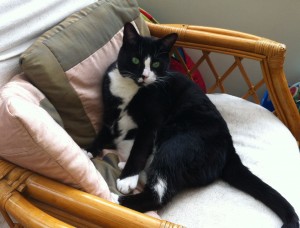
A sedentary lifestyle can lead to a pet being at risk of obesity.
What are the health risks of obesity?
Being over-weight is a huge risk factor for the development of other diseases, and can make any existing conditions much worse. This is why it is so important to ensure your pet is the ideal weight, and to put them on a diet if they are not.
- Your pet will not live as long – this is the most basic consequence of an animal being over weight. Recent studies have proved animals who are the ideal weight live 15% longer than over-weight ones. This can be up to 2 years in a Labrador, and even more in smaller breeds.
- Diabetes – being over weight is a huge risk factor for diabetes, especially in cats. However, if the animal loses the weight the diabetes can be reversed in some cases. To learn more about diabetes click here.
- Arthritis – Joint problems and pain are far more common in obese animals. The extra weight puts the joints under extra stress. Affected animals can get into a vicious cycle as the more the joints hurt, the less exercise they do, so the fatter they get. Again, losing the weight will lead to a significant improvement in the joint problems.
- Breathing problems – Animals who are over-weight will often have respiratory problems. Smaller breeds can have problems with their tracheas (windpipes), and short nosed breeds, who often have poor breathing anyway, can really struggle.
- Heart Problems – Just as in people, being obese puts the heart under extra stress.
- Heat Stroke – Animals who are over active in very hot weather can easily suffer from heat stoke, which if not treated can be life threatening. Obese animals are much more at risk from this problem as they will over heat more quickly and easily.
- Incontinence – incontinence is a common problem in older female dogs, but is particularly common in the over-weight ones. Again, this is a problem which can often be reversed by simply losing the weight.
- Cancer – in humans there is a very clear link between obesity and cancer. It is thought this same link is present in animals, but as yet the studies have not been done to prove it.
- Also, animals who are overweight or obese have a higher risk of complications if they require an anesthetic or surgery.
Understanding eating behaviour
A animals attitude to food, and their behaviour around it, are not the same as ours, and understanding this will allow you to better understand your pet.
- For dogs in particular, food is not about taste or pleasure, it is about a social hierarchy, and who has access to it.
- Access to food will establish your dogs position in the family pack –
- Your dog will see that you control its access to food, and therefore should view you as above it in the family packs order. However, this will only happen if the access to food is controlled and consistent.
- You should only feed your pet at set times, and then only from his feeding bowl to ensure you remain in control.
- If you feed your pet on demand, they will then feel that they in charge of when they get fed, and may become aggressive or demanding if you refuse to feed them.
- It is important your dog has a solid and consistent idea of their pack position. He or she will then feel secure in the family home, knowing they don’t have to struggle for position, and a secure dog is a happy and well behaved dog.
- Food as a reward –
- If you use food to reward good behaviour, or as a training aid, you must ensure it is used correctly and consistently, otherwise it can actually cause bad behaviour!
- Many people will use food as a way of ‘apologising’ or making amends to their pet, if, for example, they have been left alone a long time. This is very bad for training, as the animal then gets a treat for doing nothing. This can lead to demanding behaviour, such as over-exuberant greetings or aggression.
- If you are using food as a reward for training, ensure the reward is given immediatley as your pet does what they are told. Also, keep the treat out of sight until they have finished the task, as you can get into a situation where they will only perform if they can see the treat!
- Once training has been established, for example the ‘sit’ command, do not give a treat every time, otherwise your pet will come to expect it, and can be demanding if they don’t get it. Treating every 3rd or 4th time means they cannot predict a pattern and are always hopeful.
- Do not vary the diet
- Unlike people, animals do not get bored with food and do not need regular dietary changes.
- Regularly changing the food can encourage your pet to be fussy and start to refuse what they are given.
- If your pet refuses a type of food, and it is quickly replaced with another kind, this is rewarding the fussy eating by providing a different dish, and will reinforce the bad behaviour.
- You decide what your pet eats. You should chose a good quality food which will contain all the nutrition they need.
- If your pet does not finish their food in a given time, then remove them from the room and then take the food away. This will encourage good eating patterns as your pet will start to finish the food, which will stop them from getting hungry before the next meal time and begging for extras.
How do I get my pet to lose weight?
The simple answer to this question is to feed your pet less, and exercise it more, but it is not always as easy as that!
Feed the correct food –
- Always ensure that the food you are feeding your pet is appropriate for them.
- Puppy and kitten foods are both very high in fats and calories, as they are designed for growing active animals. Once your pet is over a year old, they should be fed a good quality adult food.
- Often we find working breeds, such as Labradors and Springer Spaniels are fed working dog food, even though they are only pets. These diets are very energy dense as they a designed for a dog who is running all day. Invariably dogs with ordinary exercise levels gain weight on these diets.
- Neutered pets are more likely to gain weight, there are now specific foods on the market available for them, especially the cats.
- Once you dog or cat is over the age of 8, they are classsed as ‘Senior’. Older animals are less energetic than younger ones, and far more likely to gain weight. Specific senior dog and cat diets will be lower in energy to compensate for this.
- If your animal is prone to weight gain, because of their breed, neutering or lifestyle, there are now many low fat complete diets on the market. Simply changing the diet to these can be very helpful. It means you can feed the same amount of food as normal, but it contains fewer calories.
- There are now also ‘prescription’ diets, which are very low in fats and calories and designed to help your pet lose weight quickly and safely. Your vet may recommend these if your pet is particularly obese, but they do not have to be fed forever, and in some cases weight loss can be achieved without them.To learn more about prescription diets, click here
There is a large range of different foods for animals, always ensure you are feeding the one most appropriate for your pet. For more advice contact your vet, or click here.
Feed the correct amount of food
- This may sound simple, but many pets are being over fed and their owners are simply not aware they are doing anything wrong.
- Always follow the recommended feeding guide on the food packet, but remember to look at how your pet is as well.
- Always feed your pet for the weight you want them to be, not the weight they actually are. For example, if your dog is 30kg and their ideal weight is 25kg, then feed for a 25kg dog.
- Weigh out your pets food. Just giving ‘ a couple of handfuls’ or ‘half a bowl’ is not accurate enough, and it can be very easy to over estimate. Either weigh the food out daily, or make a mark on a transparent container.
- If you are feeding wet and dry food together, it can be even more difficult to ensure you are not over feeding your pet. We recommend a 100% dry food diet as it is much easier to ensure you are feeding the right amounts and is much better for dental care.
- If you wish to feed wet food, ask your vets advise on how much to feed along with the dry.
- Most dry food are ‘complete’ which means they are not designed to be fed with other types of food, others are ‘complimentary’, which are designed to be fed with wet food. If you feed the recommended amount of a complete diet, and then add in a wet food as well, your pet will soon become overweight.
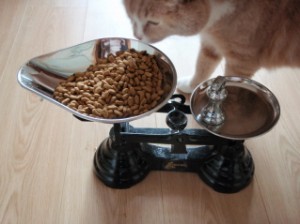
Weigh out your pets daily allowance, it is easy to make mistakes by just estimating.
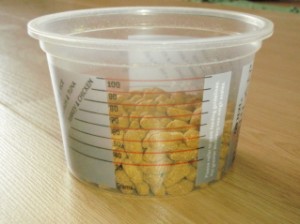
Mark a clear container with your pets daily allowance, so you don’t have to weigh the food every day. Keep this to hand, and once it is empty you know not to feed your pet anymore.
Treats
- These will often make up a surprising amount of an animals daily calorie intake, and cutting back on treats can really help your pet to lose weight.
- Often, we use treats as a way of simply saying ‘hello’ to our pets, or because we feel guilty for leaving them.
- It is important to realise that in your pets mind, love and attention from you are just as important as tasty snacks, and they will not stop loving you if you stop giving them treats.
- Make sure when you do give a treat, your pet has earned it, this will encourage good behaviour and should stop your pet begging.
- In a dogs mind particularly, you giving it food is a very important thing as they consider food to be a very valuable resource. It is not the amount you are giving them, but the fact they are receiving anything at all. Therefore a good weight loss tip is to simple halve whatever you were going to feed them, then they get a treat, but only half the calories!
- Try changing unhealthy treats like biscuits and chews, for more healthy ones such as carrots.
Table scraps
- These should never be fed to any pet, overweight or not.
- Our food is very rich, and much higher in calories than you would expect.
- Feeding table scraps also leads to begging behaviour, which is very bad manners and can be extremely distracting if you are trying to eat!
- If you cannot resist your pets pleading eyes at the table, then remove them from the room while you are eating.
- Many cats and dogs get a special ‘Sunday lunch’ along with their owners. Cutting this out will make a huge difference to their calorie intake, and occasionally feeding very rich food will often cause diarhoea.
- If you must feed table scraps, feed your pet after you have finished, from their bowl and cut back on their normal daily food.
Exercise
- Cutting back on your pets food intake is not usually enough to make them lose a significant amount of weight, increasing their exercise is important too.
- Dogs should have at least one hours exercise every day, and this should involve running around off the lead, not just a sedate walk on the lead.
- If you have trouble walking long distances, encourage your pet to play fetch with a ball or other games, where they do all the running! Alternatively, hire a dog walker.
- Encouraging cats to increase their exercise levels can be difficult but not impossible, some good tips include;
- Play with them – many cats will chase a mouse on a stick or fish on a string. Try to encourage them to play for at least 10 minutes a day.
- Make them go outside, many cats will lie all day on the sofa, and only venture outside to go to the toilet. When the weather is warm, send them outside as often as possible to explore. Even if they run straight back in, thats more exercise than they would have done otherwise!
- Put the food bowls upstairs – then they will have to climb the stairs to eat, again making them move around more.
Top Tips for Tip Top weight loss!
- Encourage good eating habits from when your pet is young;
- Feed your pet only at meal times and do not give in to demands for extra food.
- Use treats only as a training aid or a reward for good behaviour
- Do not vary the food too much, this will encourage your pet to be fussy.
- Do not encourage begging behaviour by giving in to it.
- Weigh out your pets food.
- Never estimate the amount you feed your pet, always weigh it out.
- Use a see though plastic container to mark on the amount of food, so you do not have to weigh it out every day.
- If you feed a mixed diet of dry and tinned food, remember to reduce the recommended daily allowances of each to ensure you do not overfeed.
- Feed twice daily instead of once
- Feeding two small meals a day compared to one large one can really help to keep your pet feeling full, and stop them begging for treats when they get hungry
- Feed an appropriate diet for your pet
- Consider switching to a ‘light’ diet if your pet is over weight, or prone to gaining weight.
- There are now specific diets for neutered pets, mainly cats, which are lower in calories and help prevent other health problems.
- Cut back on treats
- Treats and ‘extras’ can really add calories to your pets diet, try to cut back on them as much as possible,
- Only reward your pet when they have done something worth rewarding.
- Remember, your attention and fuss is just as important to your pet as a treat.
- When you do treat your pet, look at what is in your hand and break it in half, instantly halving the amount of calories they take in!
- Try treating your pet with carrots instead of biscuits.
- Use a ‘daily food tub’
- Keep the plastic container with your pets daily food allowance on the side. Use the biscuits out of that to treat them or give them extras.
- When the tub is empty, you know your pet has had their daily allowance, and they shouldn’t have any more.
- This is particularly good for families where more than one person feeds or treats your pet, as everyone knows when the tub is empty, thats it for the day!
- Do not give table scraps
- Table scraps are one of the biggest culprits for encouraging your pet to gain weight and if they need to go one a diet, they should be cut out completely.
- Human food is often loaded with calories, and many animals stomachs cannot cope with its richness.
- If you cannot resist your pets pleading eyes at the table, then remove them from the room while you are eating.
- Increase your pets exercise
- This is vital if your pet is to lose weight or maintain a healthy weight.
- Dogs should have at least 1 hours off the lead exercise every day.
- Encourage cats to play, or let them outside.
- Make sure they are not getting fed elsewhere
- This is particularly relevant for cats, who will often pop to the neighbours for a second breakfast!
- However, many dogs will often spend the day with family or friends while their owners are out at work.
- Make sure everybody knows that your pet is on a diet and not too feed them any extras.
Common excuses for fat pets!
- It’s the breed…
- It is certainly true that some breeds of pets, especially dogs such as Labradors are very prone to weight gain. However, this doesn’t mean they have to be fat.
- If your pet is prone to weight gain, follow the tips above and consider feeding a ‘Light’ diet as their normal ration, not just to help them lose weight.
- Plenty of people are on permanent diets to maintain a healthy weight, so why not our pets?
- They have been neutered…
- Neutering certainly makes an animal more prone to weight gain, not only does their metabolism slow down, but they are more interested in food.
- However, it is not inevitable that your pet will gain weight!
- Ensure you cut back on their daily allowance after they have been neutered, and consider feeding either a low fat diet, or one specifically designed for neutered pets.
- I feel cruel feeding them less…
- Your pet will be happier and much healthier if you cut back on their food and help them lose weight.
- Pets enjoy treats, but they also love attention and they will not love you any less if you cut back on the biscuits but give them lots of cuddles.
- Try replacing fatty treats like biscuits with healthy one such as carrot sticks.
- They won’t eat ‘diet’ food..
- It is important to persevere with dietary changes, pets will often refuse a new food at first, but don’t give up!
- Change the food over very slowly, take at least a week, adding in some of the new food and taking out the old.
- Over-weight animals are often so because they are fed a very rich diet, which is tasty but bad for them! Lighter diets are generally blander, so they may refuse them at first.
- Add interest to the diet food with fresh vegetables, resist the temptation to top it with more fatty snacks such as tinned food or fresh meat.
- I cannot exercise them any more than I do…
- Dogs should have at least one hour of off the lead exercise but this can be difficult if you have a busy lifestyle.
- Consider hiring a dog walker if you are too busy or find walking difficult, some charities will help with exercising if you are old or on a low income.
- If your dog is naughty off the lead, try dog training classes to teach them return commands and allow them to socialise with other dogs.
- Get your dog to chase a ball or play games, this way they do all the running around!
- Dog agility classes are a really fun way of exercising your pet, and are a good way to bond with your dog and teach them commands
- Try encouraging your cat to play and go outside.
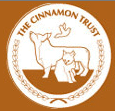
The Cinnamon Trust is a charity which will help elderly or infirm owners by exercising their pets if they are unable to do so.
Click here to be taken to their home page.
Please note, this is an advice only website, if you have any specific concerns or queries about your pets, you should contact your vet.